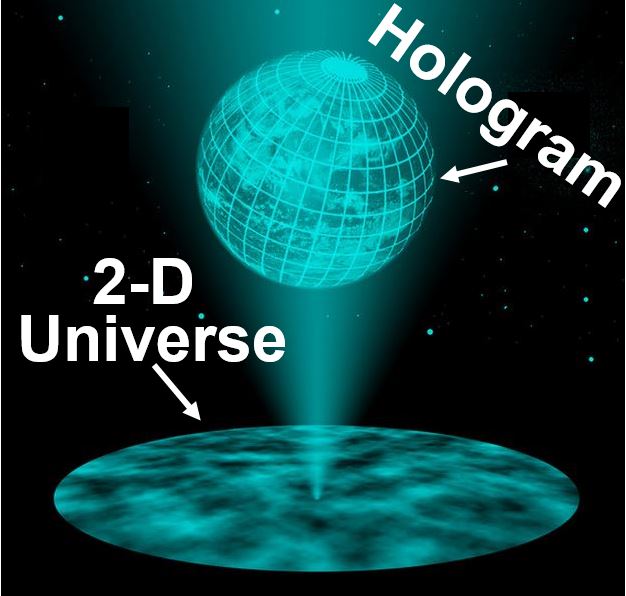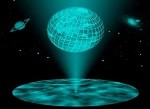Describing the Universe may not require as many dimensions as people think. According to new calculations, this may be a fundamental feature of space itself and not just a mathematical trick, says a team of scientists from Austria, India and Japan.
We are all convinced by our own eyes that the universe looks three-dimensional. However, one of the most promising theories of theoretical physics in the last twenty years is challenging this assumption.
According to the ‘holographic principle’, a mathematical description of the universe actually needs one less dimension than one would expect. What we perceive as 3-D may simply be the image of 2-D processes on a huge cosmic horizon.

Could we be living in a 2-D universe? (Image source: tuwien.ac.at)
So far, this principle has only been examined in exotic spaces with negative curvature, which is interesting as far as theories go, but such spaces are quite different from the space in our own universe.
Researchers at TU Wien (Vienna University of Technology) say that even in a flat spacetime, the holographic principle holds.
The Holographic Principle
We all know what holograms are – three-dimensional images created with photographic projections. They are, in fact two dimensional, but to us appear to be 3-D. We have seen them on banknotes and credit cars.
Our universe might behave in the same way.
Daniel Grumiller, who works at the Institute for Theoretical Physics, Vienna University of Technology, said:
“In 1997, the physicist Juan Maldacena proposed the idea that there is a correspondence between gravitational theories in curved anti-de-sitter spaces on the one hand and quantum field theories in spaces with one fewer dimension on the other.”
Gravitational phenomena are described in a three-spatial dimensional theory, the behavior of quantum particles is calculated in a two-spatial dimensional theory – and the results of both calculations can be mapped one on top of the other.
Such an association is quite surprising. It is like discovering that equations from an astronomy textbook can also be used to fix a CD player. However, this method has proved to be extremely successful.
Over 10,000 scientific papers about Maldacena’s ‘AdS-CFT-correspondence’ have so far been published.
Correspondence even in Flat Spaces
As far as theoretical physics is concerned, this is very important, but it does not seem to have that much to do with our own universe. We do not, apparently, live in such an anti-de-sitter-space.
These spaces have quite unusual properties. They are negatively curved, anything thrown away on a straight line will eventually return.
Prof. Grumiller said:
“Our universe, in contrast, is quite flat – and on astronomic distances, it has positive curvature.”
However, for quite some time Prof. Grumiller has suspected that a correspondence principle might also hold true for our real universe.
In order to test this hypothesis, gravitational theories have to be constructed, which do not need exotic anti-de-sitter spaces, but exist in a flat space.
For the past three years, Prof. Grumiller and colleagues at Vienna University of Technology have been working on that alongside researchers from the University of Edinburgh, MIT, Harvard, IISER Pune and the University of Kyoto.
Now, Prof. Grumiller and colleagues from Japan and India have published a paper in the academic journal Physical Review Letter (citation below) confirming the validity of the correspondence principle in a flat universe.
Calculated two times, Same Result
Prof. Grumiller said:
“If quantum gravity in a flat space allows for a holographic description by a standard quantum theory, then there must by physical quantities, which can be calculated in both theories – and the results must agree.”
“Especially one key feature of quantum mechanics –quantum entanglement – has to appear in the gravitational theory.”
Quantum particles cannot be described individually when they are entangled. They form a single quantum object, even if they are located far apart.
Entropy of entanglement is a measure for the amount of entanglement in a quantum system. Prof. Grumiller, together with Rudranil Basu and Arjun Bagchi, managed to show that this entropy of entanglement takes the same value in flat quantum gravity and in a low dimension quantum field theory.
Max Riegler, also from the Institute for Theoretical Physics, Vienna University of Technology, said:
“This calculation affirms our assumption that the holographic principle can also be realized in flat spaces. It is evidence for the validity of this correspondence in our universe.”
Prof. Grumiller added:
“The fact that we can even talk about quantum information and entropy of entanglement in a theory of gravity is astounding in itself, and would hardly have been imaginable only a few years back.”
“That we are now able to use this as a tool to test the validity of the holographic principle, and that this test works out, is quite remarkable.”
This is not yet compelling proof that we are indeed living in a hologram – but there appears to be growing evidence for the validity of the correspondence principle in our own universe.
Citation: “Entanglement Entropy in Galilean Conformal Field Theories and Flat Holography,” Arjun Bagchi, Rudranil Basu, Daniel Grumiller, and Max Riegler. Phys. Rev. Lett. 114, 111602. Published 19 March 2015. DOI: 10.1103/PhysRevLett.114.111602.

